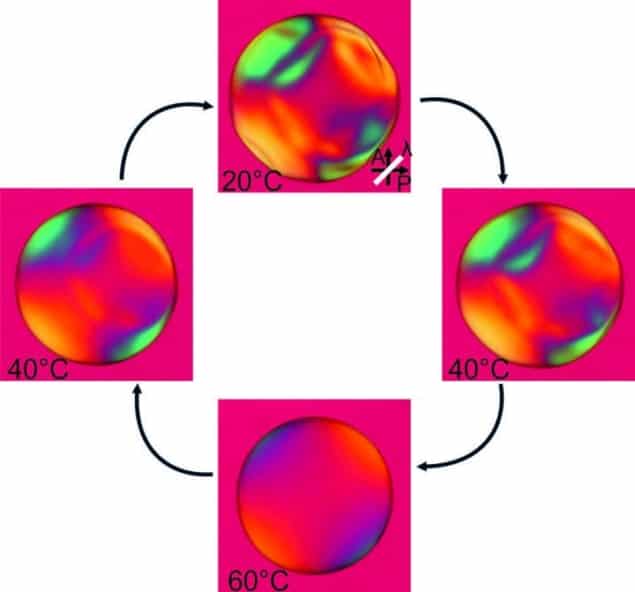Negative order appears in liquid crystals
18 Apr 2019 Belle Dumé
Researchers have observed spontaneous negative orientational order in a liquid crystal material for the first time. The result, obtained quite by chance, could help in the development of applications such as artificial muscles for soft robotics.
Liquid crystals are non-solid materials in which molecules arrange themselves in an ordered way. “This order, which is described by a scalar parameter is a very central concept in liquid crystal physics, but the negative range is frequently forgotten,” explains research team leader Jan Lagerwall of the University of Luxembourg. “Although the equation describing the parameter ranges from -1/2 to +1, it is often said that it goes from 0 for fully disordered to 1 for fully ordered.
“One of the reasons for this is that before our work, there was no liquid crystal material that spontaneously developed negative order – even though this phenomenon does occur in systems other than liquid crystals (the sticks in a Mikado game is a good example).”
Negative order is not the same as disordering, which is a state that can be achieved by heating a liquid crystal to its “clearing point” – the temperature at which it changes into a regular isotropic liquid. To obtain negative ordering, Lagerwall and colleagues say they actually cooled their system down.
“The very unusual situation in our system is this ordering, which spontaneously occurs without us acting on it in any way except cooling it, in the direction of negative order parameter,” says Lagerwall. “As shown in the video below, it is in fact more ordered than the case of zero order parameter and is a type of orientational order that we don’t normally think about.”Very unusual situation
The researchers discovered the phenomenon by chance while studying liquid crystal elastomer (LCE) shells. “My colleague Chris Yakacki of the University of Colorado Denver in the US and I started exploring a new chemistry that he had developed in the shell geometry, which is where our expertise lies. As we started to obtain some promising results, Kevin Reguengo de Sousa, a master’s student in our laboratory, informed me that something was amiss with the colours of the shells when observed in a polarizing microscope with a lambda plate inserted.”
Inverted patterns
Compared to shells previously studied, the pattern was inverted: old shells became blue, new ones became yellow. Lagerwall says that he then realized that the stretching mechanisms he and his colleagues were using to study these materials (that is, applying an osmotic pressure gradient across the shell) affected the order in the shells in a fundamentally different way to the uniaxial stretching usually employed when making LCEs.
“Negative order parameter can also be induced in an ordinary rubber balloon when it is blown up because the same type of stretching occurs, but our experiments showed that we had stumbled onto something quite remarkable when study lead author Venkata Jampaniprepared the shells at higher temperatures than usual. When cooled, the shells crumpled together, which shows that the elastomer has a ground state with significant negative order parameter, even lower than that fixed when the material is originally prepared.”
Global minimum becomes inaccessible
It is here that the LCE differs from the rubber balloon, however, he tells Physics World. “We can make sense of this behaviour by considering theories for the free energy of the material as a function of the order parameter, which actually predict a tiny local minimum. Normally, the global minimum at the positive order parameter ‘wins out’ in normal LCEs, but our way of preparing the material makes the global minimum inaccessible, so the system goes to the negative order parameter minimum instead.”
According to Lagerwall, such negative order parameter materials might be used to make actuators (artificial muscles) that are complementary to standard positive order LCE ones. “The most common way to trigger the shape change in an LCE is to heat and cool it,” explains Lagerwall. “Heating can be very fast, but cooling is often slow. This means that the actuator responds faster on heating than cooling.”
Towards faster and more powerful actuators
“Since a negative order LCE has the opposite response pattern compared to a positive one, we could combine both types of actuator for faster operation in both hot and cold directions. Here, we would heat the positive order LCE for one type of change and the negative order LCE for the opposite response.”
The team says that it is now busy gathering quantitative data on how strong the negative order is following different LCE shell preparation techniques. “We also want to continue scaling up negative order LCEs to make them larger and thicker so they actuate more powerfully,” says Lagerwall. “In our present work, which is detailed in Science Advances 10.1126/sciadv.aaw2476, we showed that we can scale up the devices, but that their optical properties are not so good as in the thinner shells. There is thus still much room for improvement.”

from physicsworld.com 19/4/2019

Δεν υπάρχουν σχόλια:
Δημοσίευση σχολίου